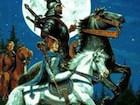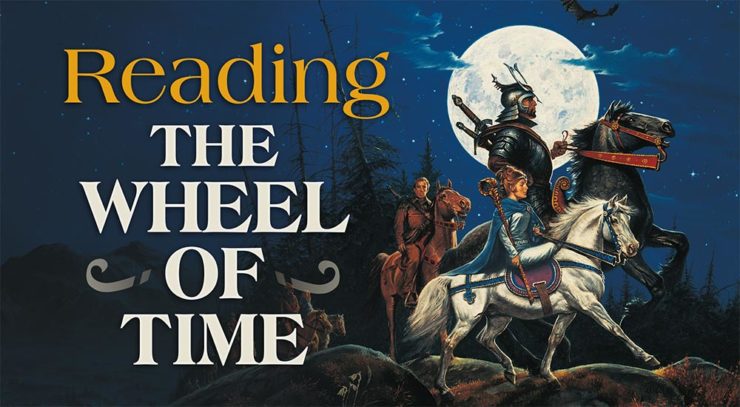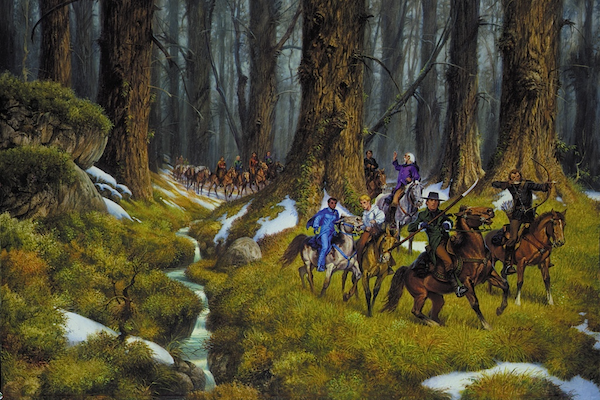The use of prophecy and fated destinies is pretty intrinsic in epic fantasy. The tradition of prophecy as a plot device in western storytelling goes back at least to the Greek epics, if not farther, and although different authors have different approaches, the theme of characters having a glimpse of the future and choosing if and how to be motivated by it runs through many of today’s great fantasy tales. But the idea of time and existence as a turning wheel adds a specific flavor to Jordan’s universe, and it’s one I’m very interested to see play out.
Welcome back to week four of Reading The Wheel of Time! I’d like to do something a little different this week; I won’t be covering any new chapters, instead I’d like to look at the dreams Rand has had so far, as well as exploring what we know of the prophecy of the Dragon Reborn and going back to look at the Prologue, which I haven’t actually covered yet. I’ll be making some observations about how prophecy plays a role in epic fantasy as well as seeing what I can predict about dreams and visions and how they may affect our heroes’ futures.
The Eye of the World opens with a bang in the Prologue. We find ourselves in what was once a beautiful palace, but one that has recently been wracked by some catastrophe. Beautiful friezes and walls have been destroyed, the floor heaves at times as though it has become a liquid, and all the inhabitants are dead, their bodies marred and mangled by some horrific force. Amidst this horror we find a man, Lews Therin Telamon, who seems unaware of the devastation around him, not even to noticing the mangled bodies beneath his feet as he searches the halls and calls for his wife, Ilyena.
Suddenly another man appears, dressed in black, who is surprised when Lews Therin does not recognize him. He mocks Lews Therin, calling on him to come back to himself, to remember, and when Lews Therin cannot, or perhaps chooses not to, the newcomer uses a power to heal the man. This causes Lews Therin great pain, but when it is over he recognizes what has happened to the palace and sees the body of his wife among the dead. Horrified and enraged, he tells the black-clad man, Elan Morin, sometimes called the Betrayer of Hope, that Lews will destroy him for what he has done, but Elan Morin tells him to remember what truly happened. It was not Elan Morin who killed everyone in the palace but Lews Therin himself, who was driven mad by the “counterstroke” of the “Great Lord of the Dark.” Elan Morin tells Lews Therin that all his companions are just as mad and are currently unleashing the same devastation on the world, that every day hundreds of other men are joining them in insanity and destruction.
Lews sees the truth then, recognizing that he himself cut down his family, even his own children, and he uses the True Source to Travel away, finding himself on a flat plain by a river, and as he screams to the Light for forgiveness, he draws power down into himself until it consumes him, striking down into the earth like lightning and creating a mountain island in the middle of the river. The black-clad man stands looking at the mountain that Lews Therin created as he died, and remarks that the Dragon cannot escape so easily, and that in fact he never can, until the end of Time.
Upon first reading the Prologue I didn’t have much of a response beyond, oh wow that was cool, I wonder what it all means! But now, having read up through Chapter 17 and learned a little more about the Power that weaves this world, I feel able to have a more nuanced perspective.
There is something epic about the Prologue, almost as though you were hearing Thom the gleeman telling you the tale. It is our first introduction to the idea of the One Power, and to the idea that there is a male half and female half. After week two’s observations on yin and yang, I notice that Lews Therin is wearing a symbol on his cloak—“a circle half white and half black, the colors separated by a sinuous line”—and that certainly sounds like a symbol for the two sides of magic working in tandem to me.
Also, when Lews Therin is touching the power before he kills himself, he is aware of the taint of “the Shadow’s counterstroke” and that said taint has “doomed the world.” Thus we get a bit of set-up for the world in which Rand Al’Thor (who is pretty definitely the reincarnated Lews Therin) lives. We also are also set up to understand that reincarnation exists in this world and that people are aware that time is a wheel that is constantly turning. The black-clad man tells Lews Therin that they “have fought a thousand battles with the turning of the Wheel, a thousand times a thousand,” and will “fight until Time dies….”
While we don’t know (at least not yet) how long each full turn of the Wheel is, there is a sense here that certain concepts of prophecy, like the idea of reincarnation, are built into this system. The struggle between the Dragon and the Betrayer seems to be cyclical, the turn of the Wheel bringing about the same battles in new forms. But this moment is different, perhaps, because it feels as if the attack upon the Dark Lord is unprecedented, and that the taint on saidin and the resulting damage are going to change the game, as it were. The Breaking of the World seems to be a one time event in all the history of the World and its ages.
So how does prophecy fit into all this? It is known that the Dragon will always eventually be reincarnated, so prophecies around when and where that will happen make sense. The prophecy that Thom relays to Rand before they arrive in Baerlon seems to suggest that people reply on prophecy to figure out if the Dragon is back yet, and what we know of Moiraine’s interest in the three boys (remember, she asks Nynaeve if any of them were born outside the Two Rivers) suggests that she is using a prophecy to guide her in looking for the Dragon Reborn.
Prophecy in epic fantasy is often used as a plot device to spur characters into action. Looking for the Dragon is what brings Moiraine and Lan to the Two Rivers, allowing our story to coalesce and the journey to begin. In Star Wars (an epic fantasy in space) the Jedi prophecy of the Chosen One is the driving force that leads to Anakin being trained as a Jedi despite the usual rules dictating that the boy is too old to begin such training. It is the factor that leads Qui-Gon to take Anakin from slavery in the first place–to take him, but not his mother, a decision that contributed greatly to Anakin’s fall. All in all, the Jedi lean upon this prophecy in one way or another throughout the Star Wars prequels, and can often be blinded to what is right in front of them because they’re too busy trying to make things fit as they believe the prophecy dictates. And even once Anakin destroys the Jedi Order, it can be debated whether or not he still is acting as the Chosen One, depending on how you choose to interpret what a “balance” to the Force truly means.
Prophecy in Star Wars comes from the driving power of creation in much the same way that it comes from the True Source, also the driving force of creation, in The Wheel of Time. In this way, the idea of what magic (for lack of a better catch-all term) is differs from, say, the Harry Potter novels, in which magic is an abstract mysterious force that exists outside of the realms of science and the “real” world. In Jordan’s universe, the “magic” used is real, concrete, less easily understood than the physical building blocks of the world but no less a part. Therefore, prophecy can be viewed merely as reading the Pattern, the way one might follow the trail of deer in the forest or tell that a storm is coming by looking at the clouds.

Min seems to have just such a gift. According to Moiraine, she can see parts of the Pattern, although she doesn’t always have the skill (or perhaps the training?) to interpret what she sees. The items she lists seeing around Perrin, for example, (a wolf, a broken crown, and flowering trees) and around Mat (a red eagle, an eye on a scale, a dagger with a ruby, a horn, and a laughing face) could be literal items, but they could also be symbols of something. Around Rand she sees many things, including lightning which is both striking at him, and coming out of him, which to me certainly seems evocative of the lightning that Lews Therin created when he channeled too much power and killed himself, creating Dragonmount. It makes me wonder if she has told Moiraine anything about what she sees around the companions, and if such clues might be useful to the Aes Sedai.
But of course, no one is telling Moiraine anything if they can help it. Rand, Mat, and Perrin all have the instinct not to confide in her about their dream, a choice that Thom deems wise, at least for now. Their suspicion of Aes Sedai in general seems to override their knowledge that Moiraine is probably the only person who might have a chance of making sense of what the dream meant and how it could be possible that Ba’alzamon could reach them in such a manner.
In an Entertainment Weekly interview in 2015, George R.R. Martin talked about the difficulty of prophecy in fantasy. He addressed the idea that it is a “staple element” in fantasy but also that you want to be “unpredictable” about it, and gives the example of the prophecy of Birnam Wood coming to the walls of Dunsinane Castle in Shakepseare’s Macbeth; Macbeth doesn’t see how it’s possible for the forest to suddenly come up to the castle and so thinks he is safe, but as it turns out, the prophecy didn’t literally mean the trees were going to move but rather referred to Malcolm and his soldiers using the branches for camouflage. Min talks about seeing “a sword that isn’t a sword” around Rand, for example, probably alluding to the Sword That Cannot Be Touched from the prophecy about the coming of the Dragon, although neither she or Rand makes that connection.
And that is the tricky thing about prophecy; it is often obscure and difficult to read. Different characters in fantasy epics make different choices about whether or not they will consider prophecies and allow them to dictate their actions, but it is usually clear that choosing your actions based to what you believe a prophecy means can be very dangerous.
Take Voldemort from Harry Potter, for example. When the prophecy is made that a child will be born that can defeat him, Voldemort is spurred into action to stop the prophecy from coming true. There are two children who fit the description of the child in the prophecy, but Voldemort decides to target Harry Potter. By attempting to kill Harry, Voldemort actually sets the prophecy in motion, giving Harry the tools to defeat him, including the protective magic Lily created when she sacrificed herself for her son as well as Harry’s connection to Voldemort’s mind. In this world not all prophecies come true (Trelawney basically only gets one prophecy “correct” out of a lifetime of making them) and so Voldemort’s choice to believe and act upon the prophecy was the catalyst that set it in motion in the first place.
It is unclear if prophecies in the world of The Wheel of Time are similarly fallible. In Susan Cooper’s The Dark is Rising Sequence, prophecies are riddles that can be used as tools to guide her heroes on their journey. Much of the prophecy in Lord of the Rings follows a similar pattern; the prophecy that one of Isildur’s heirs would take the paths of the Dead and call them to fulfill their oath was little more than a reminder to Aragorn that the option was open to him, for example. I suspect a similar pattern going forward in The Eye of the World, however, the connection to the literal pattern of time increases the fated aspect connected to prophecy.
I am also curious to see how dreams connect to this idea of prophecy and “seeing the Pattern.” It is unclear so far if Perrin or Mat have any connection to saidin the way Rand does, so I can’t yet make a call if these dreams are connected in some way to that ability. Ba’alzamon doesn’t know if Rand is “the one” aka the Dragon Reborn; the reader assumes that he’s operating along basically the same criteria as Moiraine, following a prophecy that says where the Dragon will live and how old he should be. It is therefore suggested that it is his power reaching out to Rand, and not some inherent connection. But dreams can also be prophetic, and it may be that Rand and his friends are seeing more than just a message that has been sent out to them.
So the question remains of how “real” this dream is, and if there is anything useful that Rand can take from it as a tool for the future. I suspect Moiraine could shed light on a lot of what Ba’alzamon said and did, but it’s too early to know if the threat the Dark One made—that Moiraine would kill him if she knew of the dream—is true. Thom seemed to disagree with the idea that the false dragons were “used” by the Aes Sedai; one suspects that the Dark’s idea of sacrifice in the name of the Light would be different than those who chose to serve it.
The rat thing is still super creepy though.
Next week we get back on track with new chapters (18-20) and the group will get back on track with being chased by a lot of shadowy bad guys. We’ll be talking about the breaking of fellowships, the danger of treasure-hunting, and how I listened to Howard Shore’s score for the Mines of Moria bit in Fellowship of the Ring while I was writing up my thoughts on Shadar Logoth.
Kelsey Jefferson Barrett lives and works in Brooklyn, and totally had a dream inspired by Rand’s last night. Brr.













